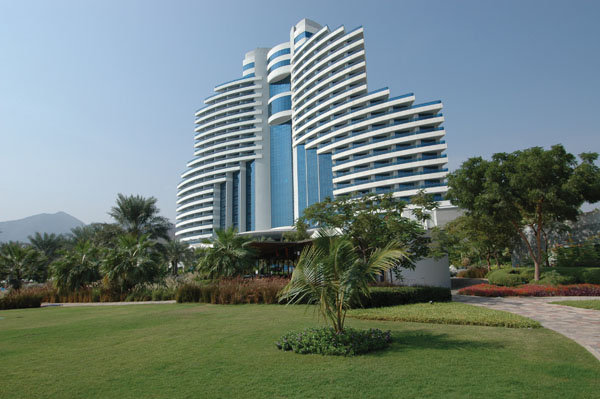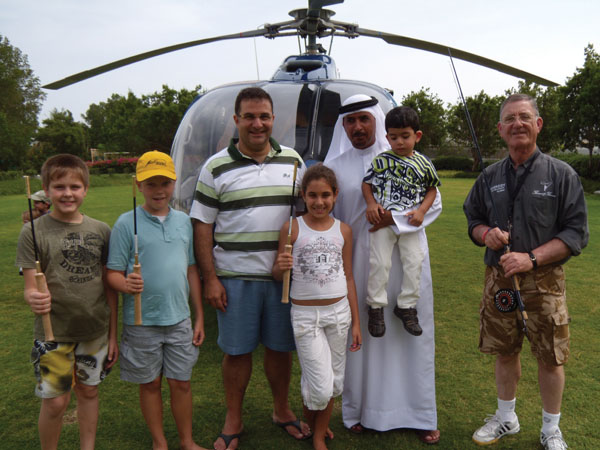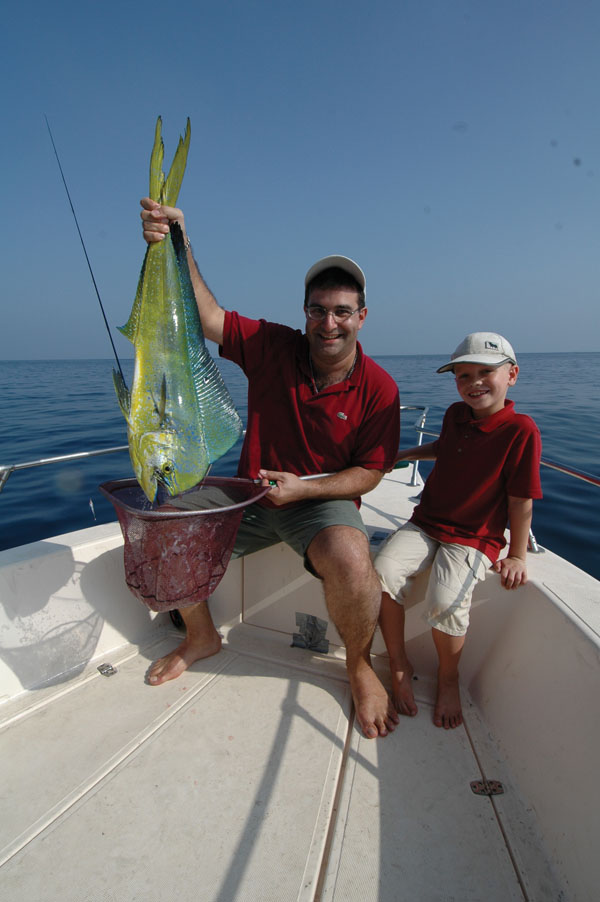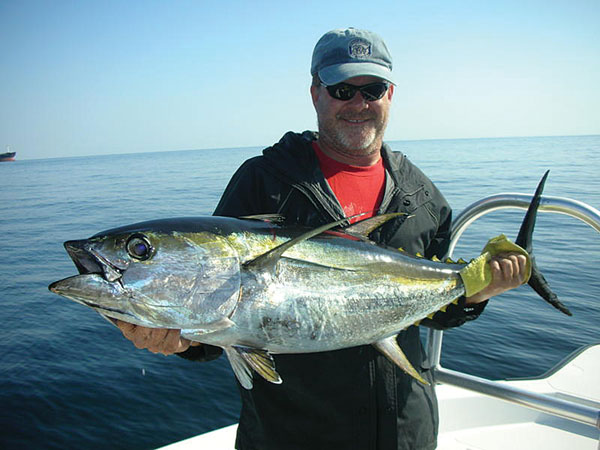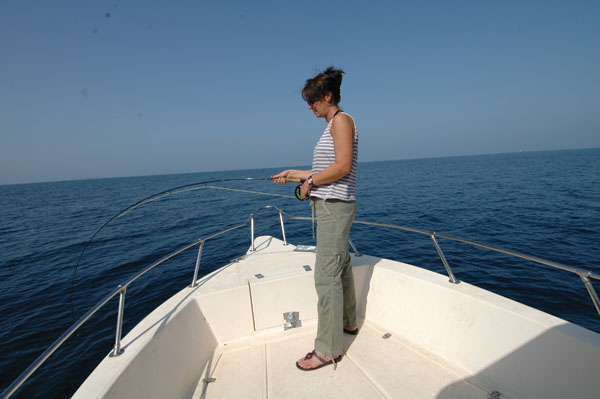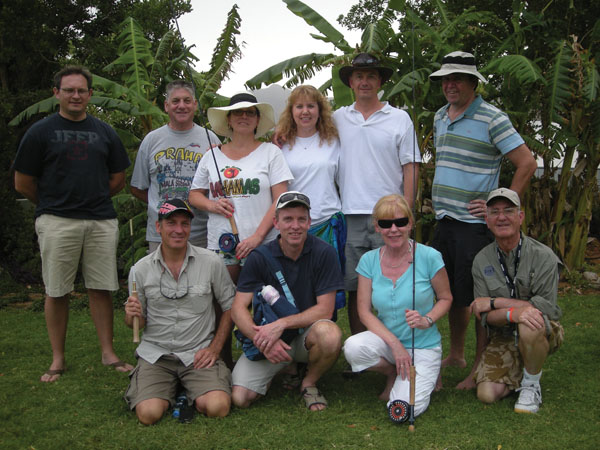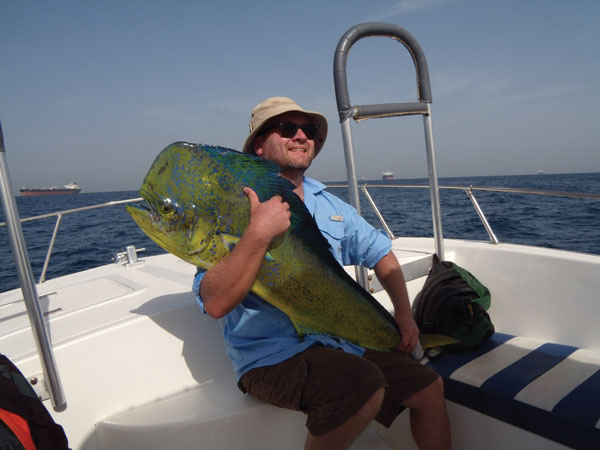In this, the fourth and final extract kindly provided by Martin James from his cracking book, At The Waters’ Edge, we follow his blue water exploits off the coast of the United Arab Emirates.
I suppose it was around 1990 when I first visited the United Arab Emirates. As usual on my travels, I had all the fly-fishing gear needed to cover most situations, as I had just finished a four week trip in the Caribbean, chasing bonefish and other species with a fly rod. My body was tanned a nice mahogany colour from being at the waterside in warm sunshine day after day.
On my first day in the UAE I stood waist-deep in the warm water of Dubai Creek, the white, soft fine sand making me feel I was back in the Caribbean. Some fifty feet in front of me were a big school of Queenfish averaging four to five pounds. I cast a size 8 white-coloured shrimp pattern, close to the fish as they attacked the bait fish on the surface. I gave two quick strips and felt a fish grab hold, a strip strike set the hook into my first fish of the session; my 7 weight rod hooped over. After a spirited fight, fish number one was unhooked and released. I reckon I probably had twenty fish that day.
But beware of the Queenfish, it has several spikes situated around its body and gill covers. The fish will do their best to stab you in the hand. They are also classified as venomous, and it can be quite painful when you have been hit several times during a day’s fishing. The use of barbless hooks makes the problem of unhooking the fish quite easy: in most cases it can be done in the water, either with forceps or by giving the fish some slack line. Sadly, today, the powers that be, have banned all fishing in the Dubai Creek. I reckon it should be opened to the fly-fishing tourist and expats. Fly fishers don’t leave bait wrappers, bits of fish and other rubbish at the waterside.
The words ‘Arabian Gulf’ or ‘Persian Gulf’ will probably conjure up visions of: war, Saddam Hussein, US aircraft carriers with their protective cover of frigates, destroyers and aircraft; desert sands, camels and oases. There is of course another vision of the Arabian Gulf. It is one that has been created by the United Arab Emirates, with beautiful hotels, parks, shopping centres and sandy beaches; also, the azure blue, warm waters of the Gulf contain many species of fish, big and small.
The second time I visited the UAE it was late October, I left Manchester on an Emirates Airlines flight; my first stop would be Dubai. I use Emirates because it’s an airline that really does put the passenger first, with excellent in-flight service. Late October is an ideal time to visit. The weather is usually perfect, the fishing good. I had come to the UAE for a few week’s fishing in Dubai, Abu Dhabi and Fujairah, where the sun shines all day, the fish keep pulling the string and bending the stick. The United Arab Emirates is much westernised and pro-British. In fact the Brits are, I believe, the only nationality that doesn’t need a visa to visit the country.
The UAE is a confederation of seven Emirates. Dubai is an emirate, as is Abu Dhabi; on the east coast is the Emirate of Fujairah, situated on the shores the Indian Ocean. This is also a great area for sports fishing. All three emirates are very modern in appearance, with the tall office blocks, great hotels, golf courses, restaurants, night life and shops or markets (known as souks) catering for the tourist, business man and sun seeker. With its good motorway network, you could be forgiven for thinking you were in a Western City. If you enjoy Chinese food, I suggest you visit the Le Meridien Hotel where they have a very nice Chinese restaurant. My daughter Sharon took me there one night, along with a group of her friends, to celebrate my birthday. It was excellent. Why not try the sweet and sour prawns, you won’t be disappointed.
Whatever your interests, you must find time to visit the fish, gold, and material souks, the latter has the finest silks in the world. The souks are fascinating. Don’t forget to visit the museum at Bur Dubai which is situated down near the waterfront. Dubai is a shopping paradise for the ladies; here you can buy the material of your choice, then get your favourite blouse or dress made up for about five pounds sterling by one of the many local tailors. For the angler, one place to visit is the fish market.
In fact, whenever I am on a fishing trip to the warmer climes I always visit the local fish market. You can learn so much with reference to the species in season and the size of fish likely to be caught. There are several tackle shops in Dubai but sadly, as I write, they do not stock any fly-fishing gear. I feel this will change in the future as more anglers take up saltwater fly-fishing. On this visit I stayed with my daughter in Dubai, but as mentioned, there are many fine hotels, without doubt the best are the Le Meridien group. They have two in Dubai and one in Fujairah which really are five stars. At the Le Miridien Al Aqah on the east coast I host a saltwater fly-fishing school; Patrick Antaki, the General Manager, must be congratulated in having the courage to open such a venture – the first of its kind in the Middle East. It gets more popular each year.
There are water sports for all, including: swimming, skiing, windsurfing, diving and snorkelling. The fishing can only be described as being very good, especially for this writer, who has had many exciting trips hunting and catching: tuna, trevally, jack crevall (probably the streetfighter of the aquatic world), Kingfish, Queenfish (often known as talang by the Arabic speaking people), barracuda, dorado also known by its Hawaiian name, Mia Mia, and various snapper jacks and grunts.
Staying at the Le Meridien Al Aqah doesn’t mean you have to miss the delights of the city. The hotel runs a courtesy coach into Dubai for those who wish to shop. Why not take a trip on an abra, a wooden boat which is used as water taxi. They cross the creek to-and-fro all day long. You will certainly enjoy a trip along this picturesque waterway, a natural inlet from the Gulf which divides the city into Deira and Bur Dubai. From the creek, traditional wooden dhows set out for the ports of India, the Gulf and East Africa, just as they have for generations. Along its banks, all the bustle of loading and unloading make it a fascinating sight and journey.
In the past, while your partner was going around the souks, you could fish the Dubai creek which runs through the City. It was great fun – a bit like fishing the Thames at Richmond. As you caught the fish, a dozen pair of willing hands would be there to relieve you of your catch. The immigrant workers are very poor, so they welcome any fish you catch. I would always take a selection of hooks and some bulk spools of line and weights, which I gave away to many of these poor people. I often sit down with them and watch how they successfully fish with their hand lines; I don’t see them miss many bites. In fact, they hit more bites than I do with rod and reel.
It’s great to watch a float in the many small harbours, catching fish from a few ounces to four or five pounds. Often, I would sit chatting with the Egyptian anglers fishing with their 30ft pole using bread paste on a size 12 hook, catching many different species, including mullet, which are great fighters. I can’t tell you the names of these numerous species of fish. It seems that everyone has a different name for them – depending on the nationality of the person you talk to. One fish you will come across is the saffie. Don’t touch this fish. Its sting is extremely painful. It will make you go dizzy often causing a minor blackout for a second or two. Imagine poking your hand down a wasp nest then multiply the experience a dozen times, that probably sums up what it feels like to touch a saffie. I learnt the hard way.
If you’re a reservoir-trout fisherman then you can have some interesting sport in the harbours and along the shoreline between October and April. In May the fishing can be OK, but choose to fish before breakfast time. A 7 weight rod with a floating line with a 9ft tapered leader down to a 12lb point will be most suitable. Don’t use the normal cold-water lines you used in the UK, they are not suitable for use in the warmer climes. You need a tropics line. I find Wulff triangle taper colour-coded lines ideal. Make sure, on your return home from fishing the creek or any other saltwater fishing venue, that you thoroughly wash down your rod, reel, line and flies. Do not neglect this job even for one day.
If you hire a boatman, treat him with respect. Try to explain the type of fishing you are doing. Remember, most people have never seen fly-fishers in the Middle East. I always take an ice chest with lots of cool drinks including water and soft drinks, some fresh fruit, sandwiches and crisps. Making sure the boatman is well fed and watered. In addition to a tip, I always make sure I give my boatman some hooks, spinners, line, etc and perhaps a tee-shirt, which they treasure as a special gift. I have noticed that gifts are often shared out among their friends, especially soft drinks, food, line and hooks. They enjoy having their picture taken. I always shoot a few pictures of these migrant workers, then, when I get back home, I send the pictures to their families back in their country of origin. Remember these guys only get to see their families once a year. Most important of all, don’t forget the sunscreen. Boat, beach or wading, don’t forget the sunscreen, I use Rieman P20, its suits me, you might need a stronger sunscreen. Don’t neglect this essential item.
Some years ago I had a day’s trolling for barracuda and kingfish. I must be honest and say it wasn’t for me. I find trolling very boring. I didn’t enjoy it; I feel watching paint dry or grass grow to be more exciting. In fact, after an hour I asked to be taken back to the harbour. Fishing the ocean over many years with fly and spinning gear in many parts of the world, I have had many exciting moments, catching: Kingfish, barracuda, tuna, queenfish, jack crevall, dorado, cobia, bonito, wahoo, tarpon, redfish, snook, bluefish, striped bass, albacore, bonefish, sailfish and sharks – many hundred pound-plus sharks, even on a fly rod. In fact, you can catch any fish on a fly, even the milk fish are being caught with this method; one successful angler in the UAE is Brian Hearne from Idaho. Brian tells me these fish are real tough fighters.
My first choice method of fishing is with a fly-fishing outfit. Should the wind be too strong I will use a spinning outfit rather than not fish at all – though I really do love chucking big bits of fluff in the salt, especially when the fish are big and I can fish a floating or slow sinking line. This for me is the ultimate in angling and something I could do for the rest of my life, if I was a millionaire.
Flying to warmer climes can be very risky when you have to rely on the baggage handlers at the airports to treat your rods with kindness. With new restrictions in force at airports, it’s now an even more worrying time for the travelling fly-fisher. Over the past three or four years I have spent a small fortune on travel rods. In the past, fishing warmer climes, I had my travel rods on board as hand luggage: sadly, not today.
I can always buy a few clothes should my luggage get lost; I can’t usually replace my rods or reels at most venues. I vividly remember flying from Canada, where I had been salmon fishing, to the west coast of Florida via Miami, to fish the Gulf of Mexico for a week. Arriving at this infamous airport, I checked my luggage then noticed my rod case was missing. After reporting the loss to the airline, I decided to have a look around. Showing my press pass to the so-called security, I was allowed to wander around with ease. I found my rod case hidden behind a small office door. That rod case wasn’t meant to be going on my flight! On another trip to Canada, aboard a Northwest Airlines flight from Gatwick to Calgary, all my luggage was lost. After a week, I had the airline fly me back home. My luggage turned up two weeks later, my Nikon cameras were missing. Not once did the airline call and give me an explanation or say sorry.
To get the best out of fly-fishing in the UAE waters you need four outfits. Fishing the harbours or from the small rocky outcrops and the shoreline for the smaller species of fish, it’s a 9ft 7 weight with a floating line. Many of these fish probably average around the pound mark, but they offer some good sport – better than the average stocked rainbow trout.
My two most often used rods are a 9ft 9 weight and a 9ft 10 weight Thomas and Thomas. If I am chasing jack crevall, giant trevally and other powerful fighters, I will switch to a Thomas and Thomas 11 weight, though there are times when it’s a 12 weight.
I always take a selection lines designed for the tropics. All are weight forward: both floating and slow sinking. I also have several Teeny lines from 200 to 500 grain. The new clear slow-sinking lines on the market are excellent for fishing in the clear waters of the Gulf. Flies are quite a simple choice: go with a selection of surface flies such as Poppers, Sliders and Gurglers. I always take a big selection of Seaducers, Bend backs, Clouser minnows and Lefty Kreh Deceivers in sizes from 1s through to 5/0s, in various colour combinations. Some bright reservoir-flies on hook sizes 12 through to 6 hooks will also do the trick when fishing the creek and harbours. In twenty years of fishing in this part of the world I learn something new on every trip. It’s been a great learning curve for me and many other fly-fishers, young and old.
After some years of heavy construction, taking place both on and offshore along the west coast of Dubai, the fishing dropped off quite dramatically, especially from the shoreline. I looked for new areas to fish, Umm Al Quwain was one spot where I reckon it’s possible to get bonefish. It’s an area of flats and mangroves; the wading is rather bad due to the very soft bottom. I would love to have a couple of weeks in the area with a small boat and outboard motor, fishing these waters. I reckon you could get a surprise or two with the fish that might grab hold of a fly on the right part of the tide.
Another area I prospected was the east coast from Dibba to Fujairah; it was a lovely-looking part of the coastline, where you could get good sport from the shoreline, especially at dawn on a flooding tide. From my first visit I fell in love with the place, it was like having a new girlfriend, I couldn’t get enough of this area. It’s where the majestic Hajar Mountains meet the ocean, in this case the blue waters of the Indian Ocean. After several years travelling down to the area with other fly-fishers, I was surprised to see a building project taking place in the area near Snoopy rock, a diving centre. I said to my wife Kate, it looks as if one of the Sheiks is going to have a palace built in this area. No doubt it will then be off limits. Eventually it became the Le Meridien Al Aqah Beach Resort .
It’s situated just fifty kilometres from Fujairah city – a popular tourist destination – and a ninety minute drive from Dubai, both of which can be accessed via the regular shuttle services running from the resort. It’s also within easy reach of the area’s natural attractions, including ancient fjords, spectacular dive sites, palm groves, picturesque waterfalls and hot springs, plus a host of historical landmarks. It is known throughout Europe and the Middle East as a place of high quality food and service, a vacation venue for all the family to enjoy. It’s certainly fun in the sun, with its unspoilt golden beach with two freshwater swimming pools and a beachside restaurant that serves delightful fish and chips. It’s perfectly placed for you to make the most of the United Arab Emirate’s year-round sunshine; fly and lure-fishing are top class, you also have diving and snorkelling opportunities. There are lot of amenities that cater for all tastes, from relaxing with a treatment at the Ayurvedic Centre to beach soccer, lazing by the pool, then dancing the night away in the rooftop bar.
No doubt it’s the fishing you are interested in, where you have a variety of species to be caught ranging from blue, big eye, black skipjack and yellow fin tuna, barracuda, King mackerel and Queenfish, rainbow runners and dorado, also on the odd occasions, the elusive sailfish. In the shallow areas there are groupers and red snappers, sherries and several other species which can offer some good sport on light tackle or fly-fishing. If your fly-fishing, remember, you need fly lines designed for the tropics. It’s rumoured there are bonefish in the Khor Kalba area. I am planning a trip in the future to explore the area.
After a day on the water, fighting some of the toughest fish that swim, you can replace all those lost calories with a wide selection of dining options, from a beachside barbecue to an à la carte dinner. Le Meridien Al Aqah Beach Resort really has it all, offering a true getaway for its guests. Don’t miss out on the Thai restaurant.
I suppose the hotel had been opened about a year when I got a telephone call from Kiran Kumar, the press and publicity officer for the Al Aqah as its often known, asking if I could meet with him and Patrick Antaki in London. As I was very busy at the time, with filming commitments, I suggested they meet me at Preston, Lancashire. We agreed to meet at four o’clock in the afternoon the following Friday. The object of the meeting was to ask me to go and sample the fishing, to make a report on the action and to take part in some promotional filming, featuring fishing offshore. After several weeks planning I flew out in October, arriving in warm sunshine.
The next day I met up with South African Wayne de Jager, a guy who could cast a fly and fish skilfully with light-spinning gear. Most important of all, he really did know how to handle a boat, a skill that is needed when you’re twenty miles or more offshore. Wayne and I hit it off from the start. During the next twelve days we caught a lot of fish; I was able to help get Wayne on the guide’s staff at Thomas and Thomas rods, arrange for him to get Gilmore reels, and through Dick Tallents at Masterline Walker, the scientific angler’s tropic lines. Before we left, Wayne put into action a plan to commission a special offshore boat built to cater for the fly-angler: it’s been a great success.
Out in the boat blood and carnage are everywhere but this is no battlefield scene, result of a U-boat attack or the aftermath of a terrorist car bomb. This scene of death is taking place on the surface of an ocean where a group of big, hungry, hard-fighting, scaly predators known as Jack Crevalle, roam the warm waters in search of food.It’s the result of an ambush on a shoal of bait-size fish. The fish litter the surface. Everywhere I look I can see and smell death, Jack Crevalles I reckon are the toughest of the tough, and they are the street fighters of the aquatic world. In Mexico they are known as ‘Toro’ – the bull. They’re half a dozen Tyson’s rolled into one. They will fight to the death, never giving an inch. Unlike Tyson, they won’t try to bite off your ear, but will savagely grab a Lefty Kreh Deceiver or other fish-like pattern of fly spinner or surface-fished plug.
With the scent of blood in the air, it seems as if every sea bird on the planet is homing in on the area. Cormorants, terns, skuas and gulls of every description are in there, fighting, squealing, screaming and diving for food, creating even more havoc. There is no escape for these bait-size fish as they are attacked from above and below.
They are trapped in this killing zone. All they can do is hope it will soon end. I cast a big Lefty Kreh Deceiver pattern into the swirling mass, two quick strips then the line is savagely pulled from my hand. Frantically, I grab hold of the fast disappearing line, then feeling it burn as it runs across my fingers. Somehow I strike in some mad, demented way and, on feeling the fish, I lift the rod shoulder high – though not for long as the rod tip is savagely pulled down under the water. The Tibor reel grudgingly gives line as a powerful adversary dives and powers away into the depths of the warm water that changes colour from aquamarine to a deep blue, then a light greenish blue colour that allows you to see down several fathoms. The sun burns down from a clear blue sky, the thermometer edges up to the 90°F mark.
Some three hundred yards of 20lb backing have gone from the reel before I’m able to make any impression on this, my sixth, jack crevalle in the past few hours. I was feeling shattered, not even knowing if I wanted another slugging session. Hussein shouted, “Keep at it Marteen,” as he poured ice cold water over my head and my sore and battered hands. I shook my head to clear the water from my eyes then cramped on more pressure, lowering the rod tip; as I did so, I got back two feet of line. I was determined that this Jack wouldn’t beat me if I could help it. The 10 weight rod bent alarmingly, I could feel the corks bend under the pressure. I was fighting this powerful leviathan for what seemed hours but was probably about thirty minutes. The fight from a jack crevalle will test man and tackle to the limit; these are wild fish with no names. I lowered the rod tip to gain a few feet of line then repeated the process and so it went on. ‘Toro’ would shake its head then dive again, taking most of the hard-won line which would have to be retrieved once more. I started gaining line for about the fifth time when I felt everything go slack. ‘Toro’ the Jack crevalle, had won this fight and its freedom.
Why should I have lost this fish I thought as I wound in the limp line: the truth was then revealed. The Albright knots, which I had practised tying all through the long winter months, had busted where backing and fly line were joined. Even on heavy tackle a thirty pound jack crevalle is not going to come in easily. Jacks will take you all over the ocean, given the chance. Sometimes you will need to follow in the boat, or lose your tackle to big jacks. They will break lines and hooks. Reels will seize up, rods will get broken and your body will sometimes cave in with fatigue and pain. Your shoulder muscles will often pop, one of the reasons why a lot of big-game anglers spend time in the gym keeping fit. This is not the sport for the wimps.
For the shore-bound angler, jacks are just as exciting, but be prepared for a mile hike along the beach when you hook ‘Toro’. They will cruise close to the shoreline in shoals or schools of similar size, hunting down the bait fish then working them into a ball before driving them into the beach; they then go on a feeding frenzy, attacking and killing anything that moves; you’re back to the aquatic battlefield with all the blood and carnage. It beats pike fishing. Jacks will hit surface-fished plugs and flies. Spinner plugs and flies fished a few feet down will also take this bullish fighter. The Mexicans don’t call him ‘Toro’ for nothing – we all know how powerful a raging bull can be. “Let’s have some lunch Hussein,” I said. “We’ve been on the water since dawn.” Hussein switched on the ignition. The 28ft Crayfish’s 200hp Volvo motor roared into life, the bows lifted and away we went, skimming across the smooth glass-like surface towards a small island.
Lunch finished, we cruised around looking for another killing zone, I had put together an 11 weight Thomas and Thomas Horizon with an Abel reel holding 300yd of backing. I wanted more of this action with Toro. Slowly we cruised around looking for signs of diving birds which would show the location of more feeding fish. For some twenty minutes there was nothing, all was silent, we scanned the ocean in all directions. Off the port bow at three o’clock, a few hundred yards away, I could see diving birds. I pointed this out to Hussein and said, “Let’s go and get another jack!” As Hussein pushed the throttle forward, so the bows lifted, we quickly moved off in the direction of the diving birds and, hopefully, feeding fish.
Coming in close, he throttled back the motor, moving upwind as he did so, to give me the best possible chance of shooting line. I made a cast some sixty feet at twelve o’clock. Three quick pulls, then a shudder went through my arm as a good fish savaged the fly hard, then dived for the ocean bottom. The flyline seemed to disappear in a blur, I noticed I was down to the yellow backing realising then 150 yards of red backing had already gone. At one time I had perhaps no more than a dozen turns of line left on the reel.
Thankfully, the fish slowed down. I cramped on as much pressure I thought the tackle could take. I gained some line. This fish gave no quarter and asked none. I thought about my knots; would they hold this time? Had I tied them right? Would the 15lb leader be strong enough? Was the fish rubbing its body on the line as it twisted and turned in its bid for freedom? All was quiet on the ocean. The seabirds and feeding fish had disappeared. It was a battle between man and fish separated by a few ounces of carbon fibre rod and some line. A helicopter carrier, with United States marines lining the ship’s side, sailed slowly past off our starboard bow. Some stretched their arms, as if to say, “How big?”
For perhaps twenty minutes, but what seemed an hour, it was give-and-take but slowly I was gaining the upper hand. First, all the yellow, followed by the red backing, was on the reel. At last I was taking in the first few turns of fly line. I knew then, barring knots letting me down or the hook pulling out, I was going to win this fight. Hussein shouted, “There it is! It’s a big jack.” He pointed downwards. I lowered the rod, taking in line then lifted again, there was a huge swirl on the surface. I caught a first glimpse of my adversary.
With his last burst of energy he dived, but only for a few feet, then I had him back on the surface. Hussein didn’t need a second chance – he got hold of the fish and it was mine. I slumped back on the padded chair, punched the air with joy, grabbing a can of cold drink from the freezer box. It was time to rest before the next round. That’s saltwater fishing with a fly rod for Toro. You have perhaps an hour of sitting around then it’s all action. “Give me much more of this” I say.
American anglers, Bryan Hearne of Idaho and Chris Myer of Oregon, two of my pupils at the Le Meridien Al Aqah Fly-fishing School in Fujairah, got a double hook up with big, hard-fighting dorado on their first day afloat during their learning experience of blue water fly-fishing. It all started the previous day in the classroom, where they were taught how to tie various knots, which included the use of the Tie-Fast tool. Discussions covered: line configuration, rod and reel, and line maintenance; types of rods, reels and lines to use and when to use them; where to find fish inshore and out deep in the ocean, and the effect of tide and weather on feeding fish. A lot of time was spent on the casting court perfecting their casting, working away until six o’clock in the evening. We all then retired to our rooms for an hour before going down to dinner.
As both pupils showed a lot of aptitude on the first day, I felt they should put into practice what they had learnt, on the ocean. Our second day started with alarm call at 4.30 in the morning, meeting up in the lobby at 5.30 for the drive to the Fujairah marina. After I introduced everyone to Wayne de Jager, we all climbed aboard his sports-fishing boat for a fast ride out into the Indian Ocean, probably twenty miles offshore. The plan was to target dorado, a fine sporting fish for the fly-rodder. Wayne, an experien-ced South African blue water fly-fisher, expected to find them around some of the ships that were moored up in the area, which is also the second largest bunkering area in the world after Singapore.
Bryan was equipped with a 10 weight Thomas and Thomas Helix, Gilmore reel with intermediate line to which was attached a small tube fly but not like those used in salmon fishing. Chris had a Thomas and Thomas Horizon II rod, Gilmore reel with a floating line. On the advice of Wayne, Chris tied on a popper tied up by Mark Bachman’s who has the fly shop in Welch’s Oregon. Some ten miles offshore in the half light of day, we spotted diving birds, changing course we went to investigate; I reckon we arrived ten minutes too late: the fish had gone. With increased engine revs, we were once again skimming across the ocean to a bulk carrier. As we got closer, Wayne slowed the engine down so we could creep in without disturbing any fish that might be in the area. We sat around for about fifteen minutes just seeing one small Dorado and a few small bait-fish. We then moved further offshore to a large gas tanker where we hit the jackpot. Within minutes I spotted two big bulls. Pointing to one fish I said, “Chris big fish at one o’clock, sixty feet.” Then: “Brian there’s a big fish off your port stern.”
The popper on Chris’s rod was quickly cast fifty feet, dropping about twenty feet from the fish which heard the plop, it quickly turned. In the blink of an eye the fish savaged the popper. Setting the hook, the fight was on as the fish cartwheeled across the ocean, taking about eighty yards of line as it gave five big jumps. After stopping for about a minute the fish changed direction, heading off towards the large gas tanker.
Again it jumped twice more before setting off on a screaming run this time towards the anchor chain, I held my breath saying to Chris, “If that fish goes between the anchor and the ship all will be lost.” Thankfully, it stayed outside. Changing direction once more, I then had Chris move down towards the stern of the boat; this was one hot Dorado that wasn’t going to give in easily. I reckon Chris would have a long fight; it was one mean, powerful fish. Meanwhile Brian was having the fight of his life. This pair of hot dorado were not going to give any quarter.
We were soon joined by a coastguard launch, which had come close in to watch the action. It was a furious give-and-take; Chris would get five feet of line back then the fish had other ideas, it would take fifty feet. As the sun climbed high the temperature increased, I started pouring cold water down Chris’s throat and the back of his neck. Forty minutes must have gone by and still no end in sight to what can only be described as an epic battle between man and fish, well out in the Indian Ocean. The perspiration was rolling off Chris as if he was in a shower. Inch by inch he got backing line onto the reel. Deep down in the clear water I could see where the fly line was joined to the backing. I reckon Chris must have felt like the ‘Old Man and the Sea’, one of Hemingway’s classics.
Slowly, with a lot of grunting and lifting, more line was gained, suddenly the fly line appeared. I had hopes then the fish would be landed. It all changed as fifty yards of line was quickly taken, at first I thought perhaps a big shark had grabbed hold of the fish. But no, it was the dorado. Chris had to start all over again with more pumping, sweating, heaving, arm-aching and a back-breaking fight to come. Once more I spotted the fly line where it joined the backing, I poured more water into Chris with encouraging words, “You’re slowly winning mate, every inch of line gained is hard won so keep at it!” Soon, the fly line is coming through the guides, deep down I could see a big expanse of blue, our quarry was coming closer, suddenly, in the blink of an eye, Chris is down into the backing once more. I could see despair on his sweat-stained face, “Keep at it Chris.” I said. Eventually, more line was being gained than lost, the fight was going our way; once again fly line was coming through the guides. Down in the water I could see this bull Dorado who had given so much in its bid for freedom, shaking its head as it continued the battle, there were more words of encouragement to Chris from Wayne, Bryan and I. Brian could only watch, having lost his big bull.
Wayne handed control of the boat over to the Sri Lankan deckhand, Dixon, and then picked up the big landing net. Inch by inch the fish was being pulled closer to the boat, soon we could see the leader; if it could be touched then victory would be with Chris, better still if we got this beast into the landing net for a picture.
Ten minutes later it was all over as Wayne got the big net over the fish’s head, then the body followed, just the last third of the fish including its powerful tail were outside the net; Wayne smartly swung it aboard, laying it on the soft seating.
I quickly took out the popper and took a few quick pictures…
To obtain a copy of Martin’s book, At The Water’s Edge, simply follow this link.


